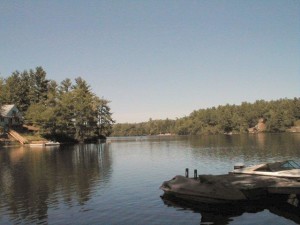Maine Citizen’s Guide to Invasive Aquatic Plant Management Just Released
Lakefront Camp For Sale on Pristine Thompson Lake, Oxford, Maine: Dream Destination
July 10, 2014Out and About for the Bangor Lakes Region of Maine July 17-23
July 17, 2014Maine Citizen’s Guide to Invasive Aquatic Plant Management Just Released
Calm Waters of Goose Pond, Shapleigh, Maine
by Leigh Macmillen Hayes
The Maine Volunteer Lakes Monitoring Program (VLMP) has released the Maine Citizen’s Guide to Invasive Aquatic Plant Management. Click on the title to open the 157-page book that is chock full of valuable information for helping prevent and/or manage aquatic infestations in your favorite lake.
Jacolyn E. Bailey, an instructor for VLMP and one of Maine’s most experienced milfoil divers, and Roberta J. Hill, Invasive Species Program Director of VLMP, co-authored the book.
This is a ready-to-use resource guide for all lake groups and those interested in protecting Maine’s lakes, ponds, streams and rivers. It focuses on “rapid response and crucial methods based on best management practices for controlling aquatic plants with the least amount of impact on wildlife and habitat.”
The book is divided into four sections. It’s filled with information, photographs of people in action, and occasional special tips and/or words of caution.
Section one includes case studies and highlights challenges, solutions and lessons learned from those who have jumped in and educated themselves and others about invasive species. The following case studies are included: Lake Arrowhead — Creative Fundraising; Little Sebago Lake — Engaging Lake Residents; Messalonskee Lake — Infestation Mapping; Pleasant (Mud) Pond — Establishing Priorities; Sebago Lake — Community Collaboration; Shagg Pond — Technology Innovation; and Thompson Lake — Informing the Public.
Section two focuses on developing an action plan and offers ways to help your group stay focused and measure progress. Examples are given throughout.
Section three is the real “nuts and bolts” chapter. Entitled “Organizing and Monitoring,” this section encourages you to take a proactive role to prevent infestations while at the same time helps you prepare for the possibility of one. It begins with how to form a steering committee and leads you through the steps all the way to sustaining your efforts for the long term.
Section four, called “Control Activities,” helps with some nitty gritty stuff like planning objectives, record keeping, permit requirements and assessing your readiness.
Section five is the final chapter of the book and includes supplemental information. Resources such as VLMP’s Web address and that of Lakes Environmental Association and several other key organizations are included. In this part of the book, you’ll also find links to forms and information on what the State of Maine is doing to tackle aquatic infestations.
For any lakefront property owner or visitor, this guide is a must read. Though it’s 157 pages long, it’s easy to read and informative. Don’t miss this comprehensive guide that will help your group develop, implement and maintain a successful management program.
For those lakes with IAP infestations, there are a limited hard copies available. Please contact the Maine Department of Environmental Protection’s Invasive Plants Program milfoil@maine.gov<mailto:milfoil@maine.gov> to request a copy.
To learn more about lakefront properties for sale on Goose Pond in Shapleigh, click on the green box above.
To learn more about the Shapleigh area, click on the blog links below.
Goose Pond, Shapleigh, Maine: Experience Halcyon Days on Serene Water
Great Fishing on Mousam and other Lakes in Shapleigh, Maine
Hikes near Mousam Lake in Shapleigh and Acton, Maine

